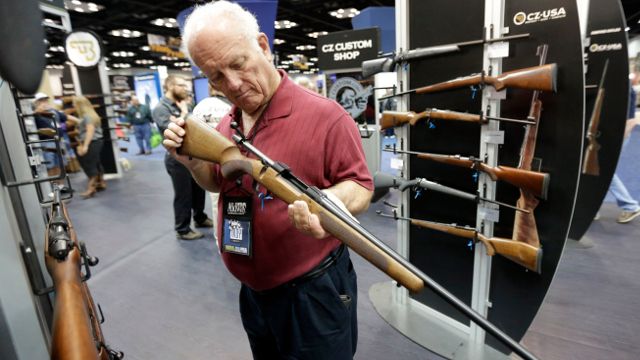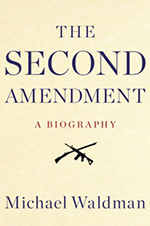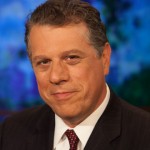
In 1871, militia and army veterans created a new organization to train American men to shoot safely and accurately: the National Rifle Association. This excerpt from The Second Amendment: A Biography recounts how the organization evolved over the years.
The NRA bills itself “the nation’s longest standing civil rights organization.” That’s not exactly how it started.
During the Civil War, Union officers had grown perturbed at the poor marksmanship of their troops. Previously, guns were inaccurate, and target practice a waste of time. Now new technology — breech-loading guns and metal cartridge ammunition — made shooting a prized skill. In 1871, militia and army veterans created a new organization to train American men to shoot safely and accurately: the National Rifle Association.
General Ambrose Burnside — yes, the same gent whose name lives to describe his distinctive whiskers — served as ceremonial president for a year. Government helped: New York state bought the NRA a rifle range to hold contests. The organization nearly collapsed when the state withdrew its support. “There will be no war in my time or in the time of my children,” New York’s governor assured the group’s leader. “The only need for a National Guard is to show itself in parades and ceremonies.” So federal officials stepped in, creating the National Board for the Promotion of Rifle Practice in 1901. It gave away surplus guns to clubs sponsored by the NRA.
Between the world wars, the federal government provided 200,000 rifles to NRA members at cost. After the defeat of Japan, with its membership swelled, the NRA began to shift its focus. Its publications dwelled on hunting and sports shooting, not paramilitary activity. The group lobbied, and was based in Washington, DC, but its principal focus was bagging deer, not blocking laws. In the late 1950s, it opened a new headquarters building to house its hundreds of employees. Metal letters spelled out its purpose in 1958: FIREARMS SAFETY EDUCATION, MARKSMANSHIP TRAINING, SHOOTING FOR RECREATION.
The NRA expressed unease with gun laws. But even as its ranks grew, it did not object to the first federal gun control measure, Franklin Roosevelt’s 1934 National Firearms Act, which banned machine guns and sawed-off shotguns. Its chief lobbyist testified before Congress. “I have never believed in the general practice of carrying weapons,” he told a House committee.”… I do not believe in the general promiscuous toting of guns. I think it should be sharply restricted and only under licenses.” A lawmaker asked him whether the proposed law violated any part of the Constitution. The witness responded, “I have not given it any study from that point of view.”
Crime remained low, and political violence minimal, in the years of consensus during World War II and the early Cold War. The tumult of the 196os fractured that calm. Gun violence began to assume the status of a public controversy.
In March 1963, an advertisement appeared in the NRA’s American Rifleman magazine:
LATE ISSUE! 6.5 ITALIAN CARBINE. Only 36″ overall, weighs only 5 1/2 lbs. Shows only slight use, lightly oiled, test fired and head spaced, ready for shooting. Turned down bolt, thumb safety, 6-shot, clip fed. Rear open sight. Fast loading and fast firing.
A man calling himself “A. Hidell” clipped the coupon and sent $21·45 to a Chicago-based mail order house to buy the military rifle. Hidell was Lee Harvey Oswald. After the assassination in Dallas, investigations angrily focused on the fact that it was possible to buy a rifle and ammunition sight unseen through the mail. Congress considered new gun laws. An NRA official testified, “We do not think that any sane American, who calls himself an American, can object to placing into this bill the instrument which killed the president of the United States.” Gun owners, however, contacted Congress to bury the bill. Lawmakers vowed an investigation of the gun lobby itself.
As the decade unfolded, political divisions took on deep cultural dimensions, pitting rural and suburban culturally conservative white voters against younger, more diverse city dwellers. Race invariably intruded. American Rifleman started a new column, “The Armed Citizen,” which profiled vigilantes. Guns & Ammo magazine said supporters of tighter gun rules were “criminal-coddling do-gooders, borderline psychotics, as well as Communists and leftists who want to lead us into the one-world welfare state.”
As Newark, Watts and Washington, DC, burned in urban rioting, and leading American public figures were assassinated, Americans began to worry we were distinctly violent. Historian Richard Hofstadter ruminated on America’s gun culture in a widely read article in the otherwise apolitical American Heritage. Gun politics deepened cultural divides, he noted. “The most gun-addicted sections of the United States are the South and the Southwest. In 1968, when the House voted for a mild bill to restrict the mail-order sale of rifles, shotguns and ammunition, all but a few of the 118 votes against it came from these regions. This no doubt has something to do with the rural character of these regions, but it also stems from another consideration: in the historic system of the South, having a gun was a white prerogative.”
In a time of backlash, the NRA grew increasingly vocal. When lawmakers trifled with it, the gun lobby showed it could retaliate at the ballot box. For years after, politicians would whisper about the intense passion of gun owners, and how they “took out” a pro-gun control senator from Maryland, Joseph Tydings, whose pelt might as well have been mounted in the NRA’s waiting room.
Still, the NRA principally spoke for hunters. It did not pose in opposition to law enforcement, or government generally, and it did not routinely invoke the Second Amendment. Though it did not support the 1968 gun bill, its opposition was muted. “The measure as a whole appears to be one that the sportsmen of America can live with,” the organization’s president assured members. In March of that year, supporting restrictions on cheap “Saturday Night Special” handguns, American Rifleman told its readers the NRA “does not necessarily approve of everything that goes ‘Bang!'” The magazine’s cover displayed a cheery defining image. A trim and chiseled man, resembling Paul Newman with a jaunty peaked cap, pine trees towering behind, held up a recently demised mountain lion.
The stance in favor of the Saturday Night Special ban set in motion forces that would supplant that grinning hunter in the NRA’s pantheon of acceptable images.
Gun group veterans still call the NRA’s 1977 annual meeting the “Revolt at Cincinnati.” One weekend in 1976, the NRA board fired 80 staff members. The next year, the organization’s leadership decided to move its headquarters to Colorado Springs, Colorado, signaling a retreat from politics. More than a thousand angry dissidents showed up at the annual convention. Many wore orange caps, and communicated by walkie-talkie. As they sweltered they insinuated that the old guard had turned off the air-conditioning. By four in the morning, the dissenters had voted out the organization’s leadership.
Activists from other groups — the Second Amendment Foundation, the Citizens Committee for the Right to Keep and Bear Arms –pushed their way into power. Neal Knox, editor of Gun Week magazine, became the NRA’s new head lobbyist. He opposed gun laws of any kind. Knox mused on whether the assassinations of the 196os were part of a gun control conspiracy. “Is it possible that some of those incidents could have been created for the purpose of disarming the people of the free world? With drugs and evil intent, it’s possible,” he wrote in Shotgun News in 1994· “Rampant paranoia on my part? Maybe. But there have been far too many coincidences to ignore.”
The NRA’s new leadership was dramatic, dogmatic and overtly ideological. For the first time, it embraced the idea that the sacred Second Amendment — not just the interests of hunters or even of homeowners — was at the heart of its concerns. The first American Rifleman after the revolt had a new paragraph under “What the NRA Is”:
The NRA, the foremost guardian of the traditional American right to “keep and bear arms,” believes that every law-abiding citizen is entitled to the ownership and legal use of firearms, and that every reputable gun owner should be an NRA member.
The NRA’s lurch to the right was part of an abrupt shift across the Republican coalition.
Forget baby boomer reveries and public television music documentaries. The rebellions of the 1960s seemed earthshaking at the time. In retrospect, the response from the right (and unnerved middle-class citizens) proved more politically potent and durable. Racial fears played an elemental part, especially as millions of white Southern Democrats left the party of their ancestors to vote Republican, first for president and then more reluctantly for Congress. Once sleepy groups galvanized as conservative activists wrested control. The NRA was one. Evangelical Christian churches underwent a similar change. Southern Baptists long had eschewed organized electoral politics. In 1976, most voted for Jimmy Carter, who became the first professedly born-again president. The Southern Baptist convention was convulsed by factional fights that led to the elevation of fundamentalist leadership — ministry devoted to the idea that Scripture was inerrant.
Even more politically, in 1979 television minister Jerry Falwell and other conservative activists formed the Moral Majority, a coalition of religious conservatives. By 1980 nearly three quarters of them voted for Reagan. Soon conservatives tossed around the language of insurrection with the ardor of a 1960s Weatherman.
The “Revolt at Cincinnati” was followed by the “tax revolt,” which began in California in 1979. Conservative activists organized to pass Proposition 13, which slashed property taxes and shrank budgets with an impact that lasted for three decades. In Arizona, Colorado and other Western states, landowners opposed the Interior Department environmental policies in a “sagebrush rebellion.” Organized business shifted, too, albeit with a less mutinous stance. Corporate lobbying had been a hushed affair, with big companies such as Procter & Gamble or General Motors wooing and contributing to Democratic and Republican incumbents alike. Power and initiative shifted to the US Chamber of Commerce and other ideologically charged coalitions. In the late 197os, the Chamber supplanted the Business Roundtable (the genteel organization of CEOs) as a free-spending lobbying organization for deregulation, tax cuts and laws to make it harder to organize a union. Business lobbying organizations became more political, more partisan, harder hitting.
The New Right stitched together causes, some intrinsically at odds with others. Social conservatives sought to restore traditional gender roles and values. Economic conservatives wanted lower taxes and a reduced regulatory role for government. Foreign policy moved Northern Catholic “Reagan Democrats” and formerly liberal Jewish “neoconservatives,” especially when Democrats seemed weak in the long twilight struggle against communism. As the rights language of the social movements of the 196os began to permeate society, conservatives began to adopt them. Young conservatives spoke less frequently of “tradition,” more of “freedom.” Broad and growing disdain for government deepened the appeal. In 1958, measured by polls, 78 percent trusted the government to “do what is right” most or nearly all the time. By the late 197os that had fallen to 25 percent.
In its new militance, the NRA fused with other conservative organizations in an overtly political coalition. Journalist Thomas Byrne Edsall, the most acute chronicler of the shift, wrote, “Over the past 40 years the Republican Party and the conservative movement have together created a juggernaut — a loosely connected but highly coordinated network of individuals and organizations — with a shared stake in a strong, centralized political machine.” The NRA became critical to that new machine, providing fierce energy and dedicated voters. From the time of the first urban rioting in 1964 until Ronald Reagan’s first year as president, membership tripled (from 600,000 to 1.9 million).
As the NRA emphasized the Second Amendment, Reagan gave the new constitutional thrust rhetorical support. The 1972 Republican platform had supported gun control. “We pledge a tireless campaign against crime — to restore safety to our streets and security to law-abiding citizens who have a right to enjoy their homes and communities free from fear. We pledge to . . . intensify efforts to prevent criminal access to all weapons, including special emphasis on cheap, readily-obtainable hand-guns . . . with such federal law as necessary to enable the states to meet their responsibilities.”
In 1975, preparing to challenge Gerald R. Ford for the Republican nomination, Reagan wrote, “The Second Amendment is clear, or ought to be. It appears to leave little if any leeway for the gun control advocate.” The 1980 GOP platform now proclaimed, “We believe the right of citizens to keep and bear arms must be preserved. Accordingly, we oppose federal registration of firearms.” It called for repeal of some existing gun laws.
That year the NRA gave Reagan its first-ever presidential endorsement.
From The Second Amendment by Michael Waldman. Copyright © 2014 by Michael Waldman. Reprinted by permission of Simon & Schuster, Inc. All rights reserved.



